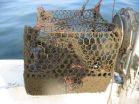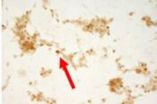(Press-News.org) HOUSTON – (Aug. 27, 2014) – The tectonic plate that dominates the Pacific "Ring of Fire" is not as rigid as many scientists assume, according to researchers at Rice University and the University of Nevada.
Rice geophysicist Richard Gordon and his colleague, Corné Kreemer, an associate professor at the University of Nevada, Reno, have determined that cooling of the lithosphere -- the outermost layer of Earth -- makes some sections of the Pacific plate contract horizontally at faster rates than others and cause the plate to deform.
Gordon said the effect detailed this month in Geology is most pronounced in the youngest parts of the lithosphere -- about 2 million years old or less -- that make up some the Pacific Ocean's floor. They predict the rate of contraction to be 10 times faster than older parts of the plate that were created about 20 million years ago and 80 times faster than very old parts of the plate that were created about 160 million years ago.
The tectonic plates that cover Earth's surface, including both land and seafloor, are in constant motion; they imperceptibly surf the viscous mantle below. Over time, the plates scrape against and collide into each other, forming mountains, trenches and other geological features.
On the local scale, these movements cover only inches per year and are hard to see. The same goes for deformations of the type described in the new paper, but when summed over an area the size of the Pacific plate, they become statistically significant, Gordon said.
The new calculations showed the Pacific plate is pulling away from the North American plate a little more -- approximately 2 millimeters a year -- than the rigid-plate theory would account for, he said. Overall, the plate is moving northwest about 50 millimeters a year.
"The central assumption in plate tectonics is that the plates are rigid, but the studies that my colleagues and I have been doing for the past few decades show that this central assumption is merely an approximation -- that is, the plates are not rigid," Gordon said. "Our latest contribution is to specify or predict the nature and rate of deformation over the entire Pacific plate."
The researchers already suspected cooling had a role from their observation that the 25 large and small plates that make up Earth's shell do not fit together as well as the "rigid model" assumption would have it. They also knew that lithosphere as young as 2 million years was more malleable than hardened lithosphere as old as 170 million years.
"We first showed five years ago that the rate of horizontal contraction is inversely proportional to the age of the seafloor," he said. "So it's in the youngest lithosphere (toward the east side of the Pacific plate) where you get the biggest effects."
The researchers saw hints of deformation in a metric called plate circuit closure, which describes the relative motions where at least three plates meet. If the plates were rigid, their angular velocities at the triple junction would have a sum of zero. But where the Pacific, Nazca and Cocos plates meet west of the Galápagos Islands, the nonclosure velocity is 14 millimeters a year, enough to suggest that all three plates are deforming.
"When we did our first global model in 1990, we said to ourselves that maybe when we get new data, this issue will go away," Gordon said. "But when we updated our model a few years ago, all the places that didn't have plate circuit closure 20 years ago still didn't have it."
There had to be a reason, and it began to become clear when Gordon and his colleagues looked beneath the seafloor. "It's long been understood that the ocean floor increases in depth with age due to cooling and thermal contraction. But if something cools, it doesn't just cool in one direction. It's going to be at least approximately isotropic. It should shrink the same in all directions, not just vertically," he said.
A previous study by Gordon and former Rice graduate student Ravi Kumar calculated the effect of thermal contraction on vertical columns of oceanic lithosphere and determined its impact on the horizontal plane, but viewing the plate as a whole demanded a different approach. "We thought about the vertically integrated properties of the lithosphere, but once we did that, we realized Earth's surface is still a two-dimensional problem," he said.
For the new study, Gordon and Kreemer started by determining how much the contractions would, on average, strain the horizontal surface. They divided the Pacific plate into a grid and calculated the strain on each of the nearly 198,000 squares based on their age, as determined by the seafloor age model published by the National Geophysical Data Center.
"That we could calculate on a laptop," Gordon said. "If we tried to do it in three dimensions, it would take a high-powered computer cluster."
The surface calculations were enough to show likely strain fields across the Pacific plate that, when summed, accounted for the deformation. As further proof, the distribution of recent earthquakes in the Pacific plate, which also relieve the strain, showed a greater number occurring in the plate's younger lithosphere. "In the Earth, those strains are either accommodated by elastic deformation or by little earthquakes that adjust it," he said.
"The central assumption of plate tectonics assumes the plates are rigid, and this is what we make predictions from," said Gordon, who was recently honored by the American Geophysical Union for writing two papers about plate movements that are among the top 40 papers ever to appear in one of the organization's top journals. "Up until now, it's worked really well."
"The big picture is that we now have, subject to experimental and observational tests, the first realistic, quantitative estimate of how the biggest oceanic plate departs from that rigid-plate assumption."
INFORMATION:
The National Science Foundation supported the research. Gordon is the Keck Professor of Geophysics and chairman of the Earth Science Department at Rice.
Read the abstract at http://geology.gsapubs.org/content/early/2014/08/14/G35874.1.abstract
This news release can be found online at http://news.rice.edu/2014/08/27/pacific-plate-shrinking-as-it-cools/
Follow Rice News and Media Relations via Twitter @RiceUNews
Related Materials:
Rice Global Tectonics Group: http://tectonics.rice.edu
Corné Kreemer: http://geodesy.unr.edu/cornekreemer/research.htm
Wiess School of Natural Sciences: http://naturalsciences.rice.edu
Images for download:
http://news.rice.edu/wp-content/uploads/2014/08/0902_PLATES-3-web.jpg
A map produced by scientists at the University of Nevada, Reno, and Rice University shows predicted velocities for sectors of the Pacific tectonic plate relative to points near the Pacific-Antarctic ridge, which lies in the South Pacific ocean. The researchers show the Pacific plate is contracting as younger sections of the lithosphere cool. (Credit: Corné Kreemer and Richard Gordon)
http://news.rice.edu/wp-content/uploads/2014/08/0902_PLATES-WEB.jpg
Rice University geophysicist Richard Gordon led a study that determined the Pacific tectonic plate is not as rigid as scientists have assumed. (Credit: Jeff Fitlow/Rice University)
Located on a 300-acre forested campus in Houston, Rice University is consistently ranked among the nation's top 20 universities by U.S. News & World Report. Rice has highly respected schools of Architecture, Business, Continuing Studies, Engineering, Humanities, Music, Natural Sciences and Social Sciences and is home to the Baker Institute for Public Policy. With 3,920 undergraduates and 2,567 graduate students, Rice's undergraduate student-to-faculty ratio is just over 6-to-1. Its residential college system builds close-knit communities and lifelong friendships, just one reason why Rice is highly ranked for best quality of life by the Princeton Review and for best value among private universities by Kiplinger's Personal Finance. To read "What they're saying about Rice," go here.
Jeff Falk
713-348-6775
jfalk@rice.edu
Mike Williams
713-348-6728
mikewilliams@rice.edu
Pacific plate shrinking as it cools
Rice, Nevada calculations challenge assumptions about rigid lithosphere
2014-08-27
ELSE PRESS RELEASES FROM THIS DATE:
NOAA's Marine Debris Program reports on the national issue of derelict fishing traps
2014-08-27
Thousands of fishing traps are lost or abandoned each year in U.S. waters and become what are known as derelict traps, which continue to catch fish, crabs, and other species such as turtles. These traps result in losses to habitat, fisheries, and the watermen who depend on the resources--losses that are largely preventable, according to a newly published NOAA study.
The report, published in the Marine Pollution Bulletin, is the first of its kind to examine the derelict fish trap problem, and so-called "ghost fishing," nationally, and recommends actions to better manage ...
Taking aim at added sugars to improve Americans' health
2014-08-27
Now that health advocates' campaigns against trans-fats have largely succeeded in sidelining the use of the additive, they're taking aim at sugar for its potential contributions to Americans' health conditions. But scientists and policymakers are still wrangling over the best way to assuage the nation's insatiable sweet tooth, according to an article in Chemical & Engineering News (C&EN), the weekly news magazine of the American Chemical Society.
In the article, Stephen Ritter, a senior correspondent at C&EN, notes that growing evidence suggests the overconsumption of ...
Participants of cardiac clinic trials do not represent real world patients, study finds
2014-08-27
A new analysis of clinical trial participation in the largest ongoing observational study of U.S. heart attack patients has found participants are not representative of the larger patient base, according to a study led by Women's College Hospital cardiologist Dr. Jay Udell. The study authors call into question the general applicability of the findings to the wider population, and suggest the use of broader enrollment criteria and existing patient registries to increase trial participation.
"We know that clinical trials can be tremendously expensive and a huge burden on ...
Promising new cancer therapy uses molecular 'Trash Man' to exploit a common cancer defense
2014-08-27
While many scientists are trying to prevent the onset of a cancer defense mechanism known as autophagy, researchers at Virginia Commonwealth University Massey Cancer Center are leveraging it in a new therapy that causes the process to culminate in cell death rather than survival. The novel treatment strategy targets the p62 protein, which is often referred to as the "Trash Man" due to its role in disposing unwanted cellular proteins during autophagy. Results from preclinical experiments suggest this experimental treatment approach could be particularly effective against ...
Dartmouth isolates environmental influences in genome-wide association studies
2014-08-27
(Lebanon, NH 8/27/14)—Dartmouth cancer researchers developed and tested an advanced statistical model to evaluate the genetic and environmental interactions that contribute to disease as published yesterday in Human Genetics.
The approach fills a gap in current analyses. Complex diseases like cancer usually arise from complex interactions among genetic and environmental factors. When many such combinations are studied, identifying the relevant interactions versus those that reflect chance combinations among affected individuals becomes difficult. In this study, the ...
Veld Fires in South Africa
2014-08-27
South Africa is entering what is described by the Volunteer Wildfire Services of South Africa as "Cape Fire Season." The Eastern Cape provincial government warned residents in certain parts of the province on Monday (8/25) of strong winds and veld fires. A high veld fire danger rating is expected in the north-western interior and along the coast in the Great Kei and Mnquma area. Strong winds often occurred along coastal regions, and during thunderstorms. The thunderstorms bring lightning strikes and subsequent fire and the wind serves to spread the fire from one place ...
Karina's remnants drawn into Hurricane Marie's spin
2014-08-27
Karina finally became a remnant low pressure area after roaming around in the Eastern Pacific for two weeks. Satellite data on August 27 showed that the now shapeless former hurricane was being drawn into nearby Hurricane Marie's circulation.
The last bulletin on Karina was issued by the National Hurricane Center on August 27 at 0300 UTC (11 p.m. EDT on Tuesday, August 26).
At that time, Karina's maximum sustained winds were near 30 mph (45 kph). It was centered near latitude 15.9 north and longitude 126.5 west. That's 1,185 miles (1,905 km) west-southwest of the southern ...
Group identity emphasized more by those who just make the cut
2014-08-27
People and institutions who are marginal members of a high-status or well-esteemed group tend to emphasize their group membership more than those who are squarely entrenched members of the group, according to new research published in Psychological Science, a journal of the Association for Psychological Science.
Research has long shown that people prefer to be in groups that are thought to have higher status or cultural value as a way of boosting self-image and projecting an impressive image to others. Despite the fact that separations between groups are often arbitrary, ...
Baicalin suppresses iron accumulation after substantia nigra injury
2014-08-27
A growing number of studies have shown that excessive iron is closely associated with the pathogenesis of Parkinson's disease. Previous studies from Chunyan Guo and co-workers from Capital Medical University in China have shown that baicalin prevented iron accumulation after substantia nigra injury, reduced divalent metal transporter 1 expression, and increased ferroportin 1 expression in the substantia nigra of rotenone-induced Parkinson's disease rats. However, the relationship between iron concentration and transferrin expression is still unclear. Based on the previous ...
Factors predicting functional recovery of the upper limb after peripheral nerve injuries
2014-08-27
Currently, the main factors thought to be associated with outcomes after the repair of peripheral nerve injuries are the age of the patient, mechanism of injury, nerve injured, injury location, defect length, repair time, repair method, operation technique, and repair materials. However, despite numerous studies of outcomes after the repair of peripheral nerve injuries, there is no agreement regarding the independent predictors of a good prognosis, and the dose-effect relationship of the predictors has not been quantified. A study by Dr. Bo He and co-workers from the First ...
LAST 30 PRESS RELEASES:
UVA’s Jundong Li wins ICDM’S 2025 Tao Li Award for data mining, machine learning
UVA’s low-power, high-performance computer power player Mircea Stan earns National Academy of Inventors fellowship
Not playing by the rules: USU researcher explores filamentous algae dynamics in rivers
Do our body clocks influence our risk of dementia?
Anthropologists offer new evidence of bipedalism in long-debated fossil discovery
Safer receipt paper from wood
Dosage-sensitive genes suggest no whole-genome duplications in ancestral angiosperm
First ancient human herpesvirus genomes document their deep history with humans
Why Some Bacteria Survive Antibiotics and How to Stop Them - New study reveals that bacteria can survive antibiotic treatment through two fundamentally different “shutdown modes”
UCLA study links scar healing to dangerous placenta condition
CHANGE-seq-BE finds off-target changes in the genome from base editors
The Journal of Nuclear Medicine Ahead-of-Print Tip Sheet: January 2, 2026
Delayed or absent first dose of measles, mumps, and rubella vaccination
Trends in US preterm birth rates by household income and race and ethnicity
Study identifies potential biomarker linked to progression and brain inflammation in multiple sclerosis
Many mothers in Norway do not show up for postnatal check-ups
Researchers want to find out why quick clay is so unstable
Superradiant spins show teamwork at the quantum scale
Cleveland Clinic Research links tumor bacteria to immunotherapy resistance in head and neck cancer
First Editorial of 2026: Resisting AI slop
Joint ground- and space-based observations reveal Saturn-mass rogue planet
Inheritable genetic variant offers protection against blood cancer risk and progression
Pigs settled Pacific islands alongside early human voyagers
A Coral reef’s daily pulse reshapes microbes in surrounding waters
EAST Tokamak experiments exceed plasma density limit, offering new approach to fusion ignition
Groundbreaking discovery reveals Africa’s oldest cremation pyre and complex ritual practices
First breathing ‘lung-on-chip’ developed using genetically identical cells
How people moved pigs across the Pacific
Interaction of climate change and human activity and its impact on plant diversity in Qinghai-Tibet plateau
From addressing uncertainty to national strategy: an interpretation of Professor Lim Siong Guan’s views
[Press-News.org] Pacific plate shrinking as it coolsRice, Nevada calculations challenge assumptions about rigid lithosphere




